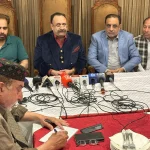Jovago recently interviewed Gabriel Gersch, a 30-years old German traveler, photographer and trekking guide.
Typically his travels take place in remote mountain ranges and wilderness areas that see very little tourism, such as Alaska, Patagonia, different regions in Africa and Central Asia.
In 2015 and 2016 he has been to Pakistan and carried out long and challenging trips in the Himalayas, the Karakorum and the Hindukush – all without guides and porters.

- What misconceptions did you have about Pakistan before coming to Pakistan?
Not that many, to be honest.
I have European friends who have been to Pakistan before, they told me all about the country. I expected beautiful and pristine mountains that are home to shepherds and traditional families.
I expended friendly, helpful, hospitable and curious people as I met them in other Central Asian countries.
And I expected a conservative culture that, compared to Europe, is more collectivistic and promotes less personal freedom. I found most of these assumptions to be fairly accurate.

What I didn’t expect is pure violence, hatred against the west and danger at every corner.
I’m not saying that Pakistan is as safe as countries in the west, even Pakistanis themselves don’t feel that way, but it’s not as dangerous as often believed in our societies.
- What makes Pakistan different from other countries you visited?
Well, Pakistan has some of the highest and most glorious mountains in the world.
Given that Pakistan’s mountain ranges are so prestigious, these places still remain fairly natural and have yet not become overly touristic. But besides its nature aspects, I also found the culture of Pakistan pretty unique and diverse.
There are relatively modern areas where unmarried men and women can walk the streets side by side with the women not covering their hair.

There are places where tourists are often seen and one can choose from numerous hotels to stay in, like in Hunza Valley. Other areas are closed to tourists and one would have to go through major troubles to get permission to enter such places.
Another aspect of what makes Pakistan unique to me is the people’s curiosity. Pakistanis always loved to hear my thoughts about their country, my country and were often eager to discuss even controversial topics. While in many
While in many other countries it seems hard for foreigners to really connect with the locals, Pakistan is a place where one can almost always have a decent conversation, as long as you find somebody to speak English with.
- Define your experience of visiting Pakistan in one sentence.
Of all the places I’ve visited, Pakistan is the country I feel the most controversial about: the beauty of the mountains and the friendliness of the people are fascinating and captivating, to say the least, but the culture is so different from mine that I know I would always be a visitor – no matter how long I would stay.
- What was the main reason you came to Pakistan in the first place?
Mountains and wilderness. My first visit was in fall 2015, when several attempts of trekking in the Hindukush failed too early snowfall and severe storms in high altitude areas.

I came back in summer 2016 for more trekking in the Himalayas, the Karakorum and the Hindukush: First I crossed the Deosai Plains from Astore to Skardu via the trail-less mountains just west of the Plains, then I hiked from Askole up to Snow Lake where I wanted to trek over Lupke La to Shimshal, but again I got snowed in at 4,700 m and had to wait several days for the weather to clear before I could return to Askole and Skardu.
In September 2016 I hiked from the upper Yarkhun Valley in Chitral to Chipursan in Hunza via Thui Pass, Darkot Pass and Chilinji Pass. On all these treks I’ve been with one or two friends from Europe, but we never hired guides or porters to accompany us.
- What dish you liked the most from the Cuisine of Pakistan?
When you return from a multiple-week-long mountain trek, any food is good – at that moment, quantity is much more important than quality. A simple biryani is fine, aclassic chicken karahi with naan is even better.
That’s what I mostly ate in the villages.








